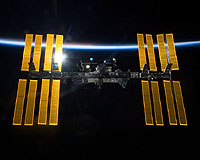 |
Paris (AFP) July 12, 2009 By the early 21st century, we would be colonising the Moon, honeymooning on Mars and scouting the moons of Jupiter, if the visions conjured by the first lunar landing were to be believed. Forty years later, the sad truth is this: today, we do not venture beyond our own backyard. Our travelling horizon lies no farther than the International Space Station, some 350 kilometres (220 miles) above our heads. The two pioneers of manned space flight,, Russia and America, have indeed been joined by China, but so far it is done no more than replicate their brief low-orbital trips of nearly half a century ago. While robots do all the real exploration of space, humans are stuck in a rut, says Francis Rocard, an astrophysicist in charge of Solar System exploration at France's National Centre for Space Studies (CNES). "There is a deep disinterest around the world for manned flight today, including in the United States," Rocard said in an interview. "There's boredom with the flights to the ISS, which nobody finds interesting, neither the media nor the public." 1969 was styled as the "giant leap" that would take us to other worlds. But, in retrospect, was it the year when we peaked? Experts say there are several reasons why our expectations have slowly deflated like a wrinkled balloon. The biggest: there is no longer any superpower rivalry -- and without it the almost limitless cash for manned spaceflight is not there. Fearing Moscow's domination of space, the United States pumped more than five percent of its federal budget into NASA in the mid-Sixties. At the programme's peak, more than 400,000 people worked on Apollo. "We didn't go to the Moon for Teflon pans or lunar rocks. We went to the Moon to beat the 'dirty commies'," is how Bill Anders, Apollo 8 astronaut, has described it. After America won the lunar race, public interest waned -- along with NASA's budget. The last three Apollo missions were axed, leaving Apollo 17, in December 1972, to close this golden age of achievement. With it came a crossroads decision on where to go next. Other worlds, even nearby Mars, were just too far away. Using slow, chemical rockets, it would be too dangerous and too expensive to send people there, and there was little point in building an outpost on the lifeless, waterless Moon. So NASA shelved the mighty Saturn V launcher, along with the lunar module, lander and return capsule. In their stead came the shuttle, based on the notion -- which proved horribly wrong -- of providing a cheap, reliable form of reusable transport for a hefty payload. But the shuttle had nowhere to go but loop around Earth, a few hundred kilometres (miles) from home. Just as Nature abhors a vacuum, so do space budgets: the ISS handily emerged to give the craft a role in its building. The tandem programmes have been badly hit by budget overruns and delays. The loss of two shuttles has prompted the vehicle to be retired next year, leaving the United States without manned spaceflight capability until possibly 2015. These problems help explain the caution that today surrounds Constellation, former US president George W. Bush's goal of returning to the Moon by 2020 and thereafter venturing to Mars. Unless President Barack Obama opens up an Apollo-style spigot, NASA will be 100 billion dollars light on how to achieve the 2020 target, says Rocard. It faces surging budget demands to build a rocket-and-capsule successor to the shuttle and extend the operational life of the ISS beyond 2015. Europe, its fingers burned by the ISS experience, is lukewarm about contributing. Mike Griffin, who stepped down as NASA boss this year, bitterly regrets the crossroads decision of the 1970s. Had the Apollo technology been retained and nurtured, the United States could be carrying out six manned flights each year, two of them to the Moon, and building a low-cost ISS by adding to the Skylab orbital station, all for 6.3 billion dollars a year, Griffin calculates. "If we had done all this, we would be on Mars today," Griffin said in an essay published in Aviation Week in March 2007. "We would have decades of experience operating long-duration space systems in Earth orbit, and similar decades of experience in exploring and learning to utilise the Moon." Jacques Arnould, a French researcher, said going beyond low Earth orbit requires international cooperation to help share costs that are beyond that of a single nation, however rich. "Making it work is not as easy as it sounds," he cautioned. "But it would be the sign of something we need, of cooperation between humans rather than rivalry." Share This Article With Planet Earth
Related Links Space Tourism, Space Transport and Space Exploration News
 Space, man's greatest challenge, 40 years after moon walk
Space, man's greatest challenge, 40 years after moon walkCape Canaveral, Florida (AFP) July 12, 2009 Forty years ago, mankind's most daunting frontier was boldly overcome when Neil Armstrong became the first man to walk on the moon, establishing America's dominance in the space race. At the height of the Cold War, Armstrong's "small step" onto the lunar surface was a giant slap in the face to the Soviet Union, which had been the first to put a satellite into orbit, and fly a man into space. ... read more |
|
| The content herein, unless otherwise known to be public domain, are Copyright 1995-2009 - SpaceDaily. AFP and UPI Wire Stories are copyright Agence France-Presse and United Press International. ESA Portal Reports are copyright European Space Agency. All NASA sourced material is public domain. Additional copyrights may apply in whole or part to other bona fide parties. Advertising does not imply endorsement,agreement or approval of any opinions, statements or information provided by SpaceDaily on any Web page published or hosted by SpaceDaily. Privacy Statement |